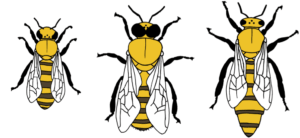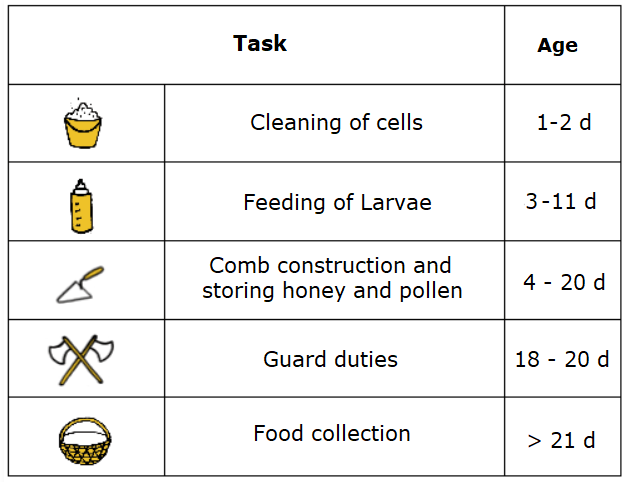The bees of a bee colony form a well-coordinated unit. Every single bee out of the thousands of honey bees, contributes to the survival of this «superorganism». The optimized division of tasks and collaboration of the bees is a unique (and quite efficient) survival strategy. But how does every bee know what to do? And what happens when this system becomes out of sync?
The Three Castes
A bee colony consists of three castes, each with their own tasks. Reproduction is reserved to the queen and the drones, while the workers take care of the nest building, the food supply and defense of the colony.
The Queen
Each colony is ruled by a single queen. She is the only reproductive female of the colony and shows her presence by the continuous secretion of the «queen substance» (or queen retinue pheromone, consisting of nine substances). This triggers following behavior in the workers, which is why the queen is usually accompanied by a so-called retinue[1].
The bees of the retinue take up the queen substance by touching the queen with their antennae and their proboscis (the tongue of the bees). They will then pass it on to the rest of the hive[2]. When the queen substance is absent, the workers will build swarm cells to raise new queens. In this way the queen is replaced immediately after her death, thus ensuring the survival of the colony. A decrease in the queen substance therefore regulates the swarming process. In larges hives the queen substance cannot be spread throughout the hive sufficiently and some bees will believe there is no queen in the hive. This is their signal that it is time to prepare for swarming 1-2].
Queens are formed from normal fertilized eggs, however the larvae are fed «royal jelly» until the cell is capped[3]. Usually several young queens are reared, of which only one will become the queen. They fight among themselves in direct duels or young queens will stab queen pupae in their cells. The battle for the throne ensures that the new queen is vital and healthy. At the age of about one week, the young queen goes on her wedding flight – usually accompanied by some workers who protect her from danger[3]. Up to 20,000 drones await the arrival of the queen at the drone gathering point, which she can locate by their scent (sexpheromone)[2]. The queen mates in mid-air with up to 17 drones[4] who die during mating. With millions of sperm in her spermatheca she returns to her colony and can now lay eggs for the coming years – up to 1200 eggs a day[3].
Drones
There are about 1000 to 2000 drones in a honey bee colony in summer. Their only task is to mate with queens, apart from that they are quite good-for-nothing and do not contribute to the maintenance of the colony. They develop from unfertilized eggs and therefore have only one mother (the queen), but no father. At about ten days of age, the drones are sexually mature and go in search of a drones gathering place. They fly up to 7 km, which avoids inbreeding. In autumn, when the mating season is over, the drones are driven from the hive or even stung by the workers – the so-called «drone eviction» has begun[3].
Workers
There can be between 10,000 and 30,000 female workers in summer. They are all daughters of the queen, but can have different fathers. A bee colony thus consists of several gene families. The workers are responsible for the survival of the colony. In the course of their lives, they undertake a variety of activities such as cleaning and building the combs, feeding the larvae and collecting nectar and pollen. In order to be able to fulfill their tasks optimally, the bees are in constant communication with each other and adapt their activity continuously to the environmental conditions and the needs of the people. In contrast to the queen, the workers normally do not reproduce. Their ovarian development is suppressed by the queen substance and the brood pheromone (consisting of 10 substances) released by the larvae[2]. In queenless colonies, however, some workers become drone mothers and begin to lay unfertilized eggs[5].

Division of labor among workers
Which task a worker does depends on her age and genetics, as well as the state of the colony, the temperature to which she was exposed as a larva and various environmental factors, such as the season and weather. This complex interplay of factors ensures that the division of labor between the workers is optimally adapted to the needs of the colony at all times.
Age-dependent tasks
Bees go through an development process which is connected with their physiological changes and determines the tasks they will perform (Figure 2). For example, the «brood food glands» is only active in young nurse bees, whereas with increasing age, more and more venom is produced, which is particularly important for guards and forager bees. This process is controlled by the so-called «juvenile hormone», which increases with the age of the bees[6-7].
However, their development process can be influenced by various factors and can even be reversed[6]. A forager bee can become an nurse bee again if necessary. Such changes can be advantageous when, for example, a colony has swarmed. Also, certain tasks are done by only a part of the bees. For example, only approx. 10% of the bees will become guards in the course of their life[8]. Similar to a bouncer, the guards patrol the entrance of the hive and check whether the bees entering the hive actually belong to the colony. Intruders of other colonies are excluded, in case of bigger dangers other hive bees are called to arms by secreting the alarm pheromone[1]. Which bees become guards is mainly determined by their genetic predisposition[8].

Transition from a hive bee to a flying bee
The relationship between hive and forager bees is important for the development of the colony. The transition from the hive to the forager bee is therefore closely managed. Both the forager bees and the larvae give off a certain substance «ethyl oleate». High amounts of this substance slow down the development to a forager bee, while small amounts accelerate it [9-11]. This keeps the ratio of nurse and forager bees in balance. In addition, the development of flying bees is also influenced by the food supply and the weather. Scarce honey or pollen stocks accelerate development, while bad weather slows it down, as the forager bees can fly out in dry weather[12].
Specialization of forager bees
The forager bees are again divided into pollen, nectar and water collectors. Compared to nectar collectors, pollen collectors are bees with better learning abilities[13]. The learning ability is influenced by the genetics of the bee, but also by the temperature to which the bee was exposed as a larva[14]. Warmer temperatures promote the learning ability at the later stage of their lives[15]. In addition, the proportion of pollen collectors is adapted to the needs of the colony. A scent is emitted by the young larvae (β-Ocimen), which encourages the bees to collect pollen and ensures the brood of a proportional food supply[16]. On top of that, bees can also estimate the pollen supply; the larger the supply, the fewer pollen collectors are recruited[17].
Synchronization of work
The workers have various signals at their disposal to coordinate their activities. The vibration signal, in which the bees vibrate their bodies for 1-2 seconds dorsoventrally, increases the activity of the entire colony. It is used in the morning to begin the working day in a coordinated manner[18]. Further, if there is a traffic jam when unloading nectar and pollen, the forager bees perform the trembling dance, by twitching their bodies and flap their wings[19]. Hive bees will then move in to help unloading the food. Fragrances also play an important role in the communication. For example, the fragrance emitted during the waggling dance prompts resting forager bees to take up their work[20].
Strong together
A bee colony is a small miracle of nature. The for the eye apparent chaos is in practice a sophisticated systems, with a large degree of cooperation. Individually a honey bee would not be able to survive, together however they are a strong and efficient superorganism.
Literature
1. Slessor, K. N., Winston, M. L. & Le Conte, Y. Pheromone communication in the honeybee (Apis mellifera L.). Journal of Chemical Ecology 31, 2731-2745, doi:10.1007/s10886-005-7623-9 (2005).
2. Trhlin, M. & Rajchard, J. Chemical communication in the honeybee (Apis mellifera L.): a review. Veterinarni Medicina 56, 265-273 (2011).
3. Dietemann, V. et al. Das Schweizerische Bienenbuch – Biologie der Honigbiene. VDRB (2014).
4. Page, R. E. Sperm utilization in social insects Annual Review of Entomology 31, 297-320 (1986).
5. Page, R. E. & Erickson, E. H. Reproduction by worker honey bees (Apis mellifera) Behavioral Ecology and Sociobiology 23, 117-126, doi:10.1007/bf00299895 (1988).
6. Huang, Z. Y. & Robinson, G. E. Honeybee colony integration – worker worker interactions mediate hormonally regulated plasticity in dividson-of-labor. Proceedings of the National Academy of Sciences of the United States of America 89, 11726-11729, doi:10.1073/pnas.89.24.11726 (1992).
7. Huang, Z. Y., Robinson, G. E. & Borst, D. W. Physiological correlates of divison-of-labor among similarly aged honey bees. Journal of Comparative Physiology a-Sensory Neural and Behavioral Physiology 174, 731-739 (1994).
8. Breed, M. D., Guzman-Novoa, E. & Hunt, G. J. Defensive behavior of honey bees: Organization, genetics, and comparisons with other bees. Annual Review of Entomology 49, 271-298, doi:10.1146/annurev.ento.49.061802.123155 (2004).
9. Leoncini, I. et al. Regulation of behavioral maturation by a primer pheromone produced by adult worker honey bees. Proceedings of the National Academy of Sciences of the United States of America 101, 17559-17564, doi:10.1073/pnas.0407652101 (2004).
10. Amdam, G. V. Social context, stress, and plasticity of aging. Aging Cell 10, 18-27, doi:10.1111/j.1474-9726.2010.00647.x (2011).
11. Le Conte, Y. & Hefetz, A. in Annual Review of Entomology Vol. 53 Annual Review of Entomology 523-542 (2008).
12. Amdam, G. V. & Omholt, S. W. The hive bee to forager transition in honeybee colonies: the double repressor hypothesis. Journal of Theoretical Biology 223, 451-464, doi:10.1016/s0022-5193(03)00121-8 (2003).
13. Page, R. E., Scheiner, R., Erber, J. & Amdam, G. V. in Current Topics in Developmental Biology, Vol 74 Vol. 74 Current Topics in Developmental Biology (ed G. P. Schatten) 253-+ (2006).
14. Becher, M. A., Scharpenberg, H. & Moritz, R. F. A. Pupal developmental temperature and behavioral specialization of honeybee workers (Apis mellifera L.). Journal of Comparative Physiology a-Neuroethology Sensory Neural and Behavioral Physiology 195, 673-679, doi:10.1007/s00359-009-0442-7 (2009).
15. Tautz, J., Maier, S., Groh, C., Rossler, W. & Brockmann, A. Behavioral performance in adult honey bees is influenced by the temperature experienced during their pupal development. Proceedings of the National Academy of Sciences of the United States of America 100, 7343-7347, doi:10.1073/pnas.1232346100 (2003).
16. Traynor, K. S., Wang, Y., Brent, C. S., Amdam, G. V. & Page, R. E. Young and old honeybee (Apis mellifera) larvae differentially prime the developmental maturation of their caregivers. Animal Behaviour 124, 193-202, doi:10.1016/j.anbehav.2016.12.019 (2017).
17. Fewell, J. H. & Winston, M. L. Colony state and regulation of pollen foraging in the honey bee, Apis mellifera L Behavioral Ecology and Sociobiology 30, 387-393 (1992).
18. Schneider, S. S. & Lewis, L. A. The vibration signal, modulatory communication and the organization of labor in honey bees, Apis mellifera. Apidologie 35, 117-131, doi:10.1051/apido:2004006 (2004).
19. Dyer, F. C. The biology of the dance language. Annual Review of Entomology 47, 917-949, doi:10.1146/annurev.ento.47.091201.145306 (2002).
20. Thom, C., Gilley, D. C., Hooper, J. & Esch, H. E. The scent of the waggle dance. Plos Biology 5, 1862-1867, doi:e22810.1371/journal.pbio.0050228 (2007).